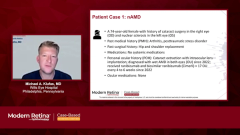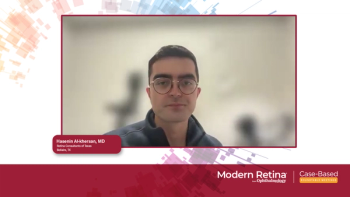
Case 3: Achieving Rapid Fluid Resolution in nAMD With Faricimab
A panelist discusses how a woman aged 77 years with bilateral neovascular age-related macular degeneration (nAMD) demonstrated different responses to treatments between her eyes, showing a superior response to faricimab in her right eye compared with ranibizumab, highlighting how some patients may respond better to specific anti-VEGF agents.
Clinical Brief: Treatment Selection for nAMD
Main Discussion Topics
- Differential Treatment Response: A woman aged 77 years with bilateral nAMD shows varying response to anti-VEGF agents between eyes.
- Medication Switching: The patient demonstrated a superior response to faricimab compared with ranibizumab in the right eye, with waxing and waning fluid corresponding to medication changes.
- Treatment Barriers: Insurance coverage issues affecting medication selection and continuity, requiring temporary switches between agents.
- Long-Term Management: Discussion of treatment extension beyond 16 weeks with aflibercept 8 mg, with data supporting 20- to 24-week intervals in some patients by years 2 to 3 of treatment.
Key Points for Physicians
- Some patients demonstrate eye-specific responses to different anti-VEGF agents.
- Consider maintaining treatment intervals despite some persistent exudation if vision remains stable.
- Insurance requirements and step therapies may influence treatment selection.
- Three-year data indicate nearly 50% of patients on aflibercept 8 mg can reach 20-week intervals and 25% can reach 24-week intervals in both nAMD and diabetic macular edema (DME).
Notable Insights
- Observing response at 2 weeks post injection may help differentiate between durability issues and tachyphylaxis.
- Patients with pigment epithelial detachments may benefit from specific agent selection (eg, aflibercept).
- Safety profiles are favorable across second-generation retinal vascular agents.
- Extended treatment intervals require careful monitoring strategies and patient education about reporting vision changes.
Clinical Significance
The expanding armamentarium of second-generation retinal vascular agents offers clinicians multiple options for individualized treatment, with the potential for significantly extended treatment intervals that reduce patient burden while maintaining disease control in nAMD and DME.
Newsletter
Keep your retina practice on the forefront—subscribe for expert analysis and emerging trends in retinal disease management.










































